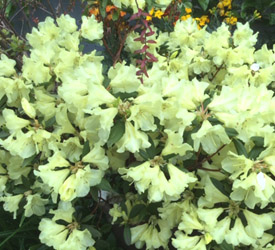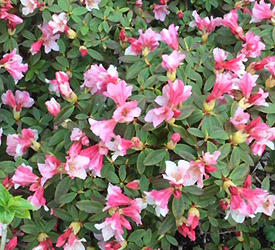Warren Berg's hybrid Rhododendrons
Some outstanding Rhododendron hybrids were developed by the late Warren Berg, who had a wonderful woodland garden in Pt. Ludlow, Washington. Warren was a plantsman extraordinaire and very much a part of the great Rhododendron hybridizing community in the Pacific Northwest.
Warren was one of the plant hunters who joined trips into Asia, particularly China, just as China re-opened to western plant hunters in the latter part of the 20th century. He often used seed of species he'd collected to grow plants and evaluate their potential both for local garden use and as parents in crosses. He wanted to create good, easy to grow small plants for modern gardens. He also wanted nice foliage displays as well as a range of flower colours.
Warren named his cultivars so people would recognize the hybridizer, and want to collect as many of his cultivars as possible. He often used "bee" in the hybrid name – the "bee" coming from his last name. So, you'll find plants named 'Patty Bee', 'Peter Bee', 'June Bee', 'Honey Bee', etc. There are exceptions, depending on who was being honoured with a cultivar name, hence the plant names 'Ernie Dee; and 'Ginnie Gee'. One of my favourite rhododendrons is 'Golfer', named for Warren's wife Patricia who was an avid golfer. 'Patty Bee' was also named for her.

R. 'Patty Bee'
One of Warren's favourite parents for hybridizing was R. keiskei 'Yaku Fairy', a dwarf, yellow-flowered species from the Japanese island of Yakushima. In addition to providing small plant stature, this species gave him genetic material for his yellow flowers as well as good foliage. And, it was a plant that would cross readily with other species to provide a range of flower colours.

R. 'Wee Bee'
For yellow flowers, look for 'Patty Bee', 'Peter Bee', and 'Golden Bee'. Good pink forms are 'Wee Bee' and 'Too Bee', and forms that are white, or open white flushed with pink include 'Ginnie Gee', 'Ernie Dee', 'June Bee' and 'Wanna Bee'. For one of the most outstanding foliage plants around, you can't beat the aforementioned 'Golfer'. This cultivar has lovely pink flowers, but what I really love is the new foliage that is so covered by indumentum that it appears white. By the end of summer, as the foliage matures, the indumentum is gradually lost, but is replaced with attractive blue-green leaves. They are all "good do-ers" both in the garden or in containers. So, "bee happy" and treat yourself to one of Warren's beautiful creations.